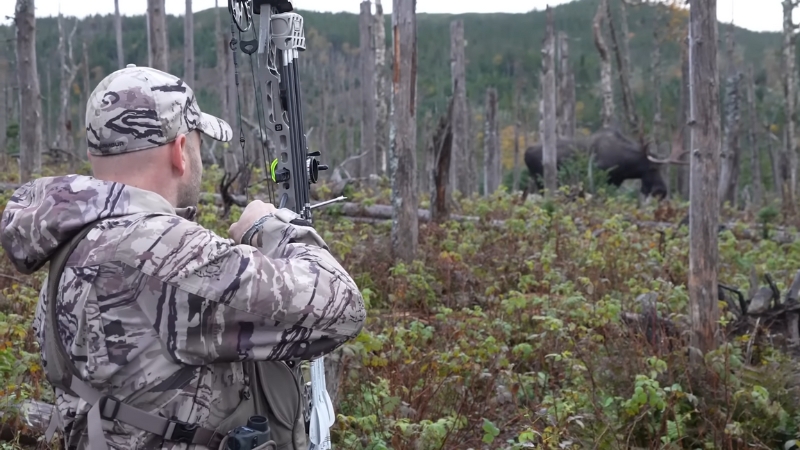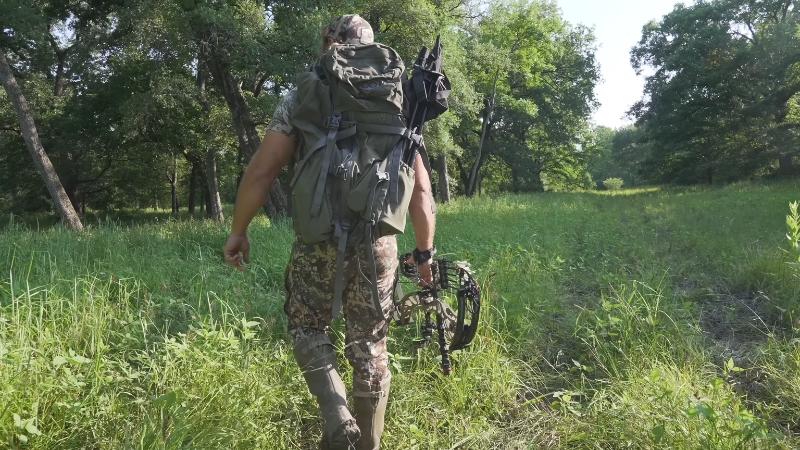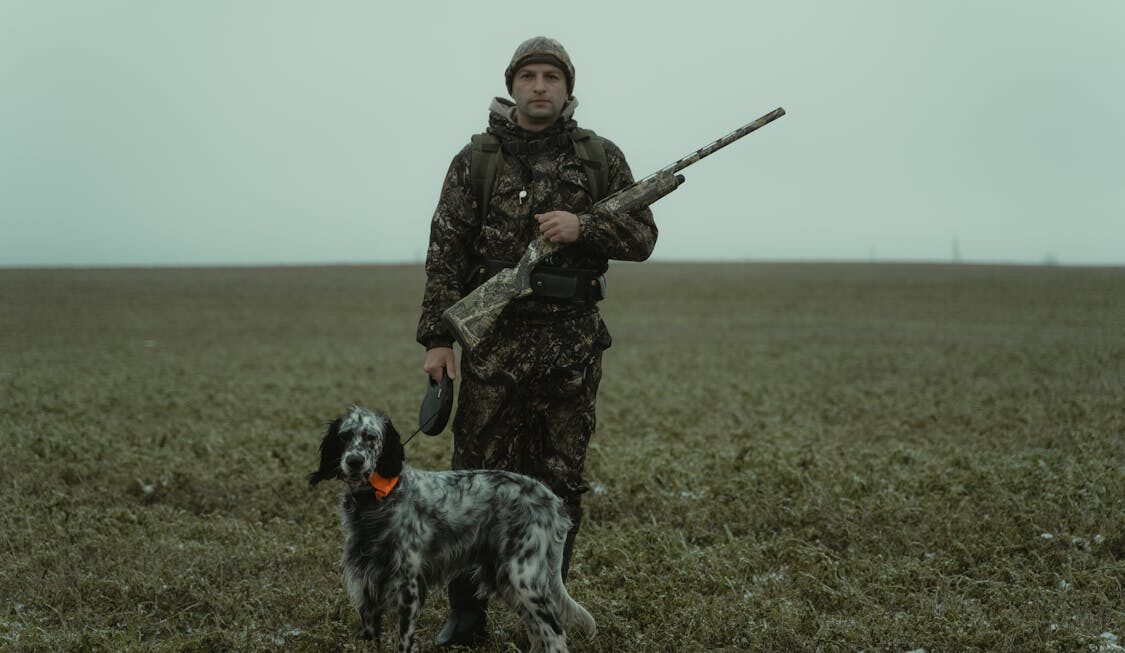From a high perch in a tree, a hunter silently watches as two cautiously step out of the brush. Their ears swivel, scanning for any sound of danger.
The forest is quiet except for the soft rustle of leaves as a buck appears at the edge of the clearing.
The hunter’s heart races; weeks of tracking this magnificent animal have led to this moment.
The buck’s antlers gleam in the morning light as he steps further into the open. The hunter waits, bowstring drawn, knowing the perfect shot requires patience and precision.
As the buck moves into position, an arrow silently flies through the air.
Months of preparation culminate in this single, thrilling moment.
Why Bow Hunting?

Bow hunting isn’t just about harvesting game; it’s about embracing the challenge.
If the thought of patiently waiting, carefully aiming, and experiencing the natural world up close excites you, then bow hunting might be for you.
This form of hunting connects you to a primal way of life, relying on skill, timing, and practice.
Compared to firearm hunting, bow hunting offers a closer, more intimate experience.
Shots are taken at shorter ranges, and success depends on understanding your equipment and the habits of the game you’re pursuing.
Bow hunting also fosters a deeper appreciation for nature and the animals you hunt.
Getting Started: Equipment Matters
Choosing the right bow and accessories is essential for a successful hunt. Here’s what you need to know:
Compound Bows
A compound bow uses a system of cables and pulleys to multiply the energy applied to an arrow.
- Advantages: Easier to draw and hold at full draw, allowing for a steadier aim.
- Adjustable: Most models allow you to modify draw weight and length to match your needs.
- Cost: Typically more expensive, but ideal for beginners looking to transition from practice to hunting.
Traditional Bows
Traditional options include longbows and recurve bows.
- Recurve Bows: Compact and powerful, with interchangeable limbs for adjusting draw weight.
- Longbows: Simplistic design with a nostalgic appeal, requiring more skill and practice.
- Advantages: Cost-effective and great for developing fundamental archery skills.
Selecting the Right Bow
View this post on Instagram
Visit a local archery shop to test bows and get professional advice. Factors to consider:
- Draw Length: Measured by your arm span divided by 2.5. Ensures comfort and accuracy.
- Draw Weight: Beginners should start with a lower draw weight (20-30 lbs) for practice. For hunting, a minimum of 40 lbs is recommended, with 45-60 lbs being ideal for larger game.
- Fit: Ensure the bow matches your dominant hand and feels comfortable.
Essential Accessories
To complete your setup, invest in the following gear:
- Arrows: Choose arrows suited to your bow’s draw weight and length. Carbon fiber arrows are durable and reliable.
- Broadheads: Fixed-blade heads are sturdy for traditional bows, while mechanical heads often work best with compound bows.
- Arrow Rest: Keeps the arrow steady. Options include whisker biscuits, drop-away rests, and stick-on types.
- Arm Guard: Protects your forearm from the bowstring.
- Release Aid: Assists with a smooth release, improving accuracy.
- Quiver: Holds your arrows; options vary for compound and traditional setups.
- Bow Case: A necessity for safe storage and transport.
Learning to Shoot
Developing proper form and technique is key to accuracy and confidence. Here are the basics:
Stance
The foundation of accurate shooting starts with a proper stance. Begin by standing with your feet shoulder-width apart. Position yourself so that your body is perpendicular to the target, creating a stable base. This orientation allows for better alignment and balance during the shot.
For right-handed shooters, place your left foot slightly forward, creating a natural line toward the target. Left-handed shooters should reverse this, with their right foot leading. Ensure your feet feel comfortable and grounded to maintain stability through the shot.
Your shoulders should remain aligned, forming a straight line from your bow arm to the target. Keep your bow arm extended but avoid locking your elbow, as a slight bend prevents tension and promotes smoother shooting mechanics.
Grip
How you grip the bow can greatly impact your accuracy. Hold the bow gently, letting it rest in the web of your hand between the thumb and forefinger. The grip should feel natural and relaxed, with no excessive pressure.
Avoid squeezing the grip tightly, as this can create torque and twist the bow upon release, leading to inconsistent shots. Think of your grip as a soft cradle, allowing the bow to do its job without interference. Focus on maintaining this light grip throughout each shot.
Anchor Point
@adjustablereddot Anchor points are vital in archery! And knowing how to set up your bow sight to have a comfortable and repeatable anchor with our sight will help you be accurate! . . . #archery #bowhunting #targetpractice #bowhunting #reddotsights #adjustablereddot #ardbowsight ♬ original sound – Adjustable Red Dot
An anchor point is a reference position on your face where your release hand consistently comes to rest. This consistency is critical for accuracy.
For most archers, popular anchor points include the corner of the mouth, the side of the jawline, or the tip of the nose. Experiment to find what feels most natural and repeatable for you.
Mark this position in your mind and ensure your release hand touches this spot every time you draw the bowstring. A solid anchor point eliminates variability and keeps your shots precise.
Aiming
Aiming requires a blend of focus and technique. Begin by using the bow sight to align with the target. The sight’s pin should rest on your intended point of impact.
For greater accuracy, narrow your focus to a small spot rather than the whole target. For example, aim for the center of a bullseye or a specific tuft of fur on an animal. By concentrating on a defined point, you’ll naturally improve your precision.
Control your breathing as you aim. A steady breath can stabilize your shot and reduce movement caused by nerves or fatigue. Take a deep inhale, exhale slightly, and hold steady as you prepare to release.
Release and Follow-Through
A smooth release is the hallmark of a good shot. Use your release aid or fingers to let the string go gradually, rather than jerking it. Think of it like squeezing the trigger on a rifle—slow and deliberate.
Once the arrow is released, maintain your form. Keep your bow arm steady and your sight on the target. Avoid the temptation to drop your arm or look for the arrow mid-flight. This follow-through ensures the arrow stays on its intended path and hits the target accurately.
Practice these steps regularly to build muscle memory and confidence. Over time, each movement will feel fluid and instinctive, setting you up for success on the range and in the field.
Vital Gear for Hunting Success
There’s a lot of hype around bowhunting gear and how you should be shooting it.
So what should you focus on when it comes to shooting, and what gear upgrades and investments are worthwhile?
Listen to the full podcast episode: https://t.co/ypm1dzivUM#hunting #bowhunting pic.twitter.com/WbNt1OUDpz
— Outdoor Life (@outdoorlife) August 21, 2024
Having the right hunting gear ensures safety and effectiveness:
- Helps determine exact distances for accurate shots.
- Treestand and Harness: Essential for elevated hunting positions, providing safety and a clear view.
- Camouflage: Blends you into the surroundings, reducing the chance of being spotted.
Bow Hunting Ethics
Bow hunting requires respect for wildlife and the environment. Ethical hunting includes:
- Only take shots you’re confident in to ensure a humane harvest.
- Know the vital areas for a clean kill.
- If your shot doesn’t drop the animal immediately, follow blood trails and other signs diligently.
The Rewards of Bow Hunting

Bow hunting isn’t just a hobby; it’s a discipline that teaches patience, precision, and perseverance. It’s a journey back to nature, providing unforgettable moments like the quiet stillness of a morning hunt or the thrill of a successful shot.
As Fred Bear, a legendary bow hunter, once said: “The exercise in the fresh air, the chance to get away from everyday pressures and problems, a return to the basic relationships between man and his environment”—that’s what makes bow hunting truly special.




